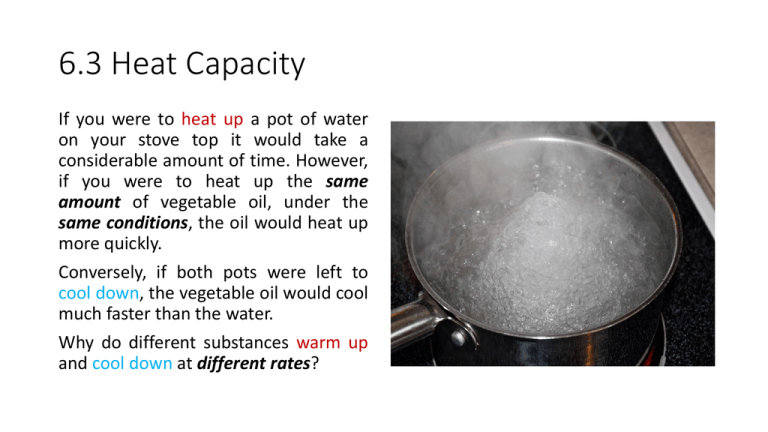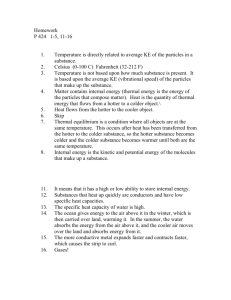specific heat capacity (c)
advertisement

6.3 Heat Capacity If you were to heat up a pot of water on your stove top it would take a considerable amount of time. However, if you were to heat up the same amount of vegetable oil, under the same conditions, the oil would heat up more quickly. Conversely, if both pots were left to cool down, the vegetable oil would cool much faster than the water. Why do different substances warm up and cool down at different rates? 6.3 Specific Heat Capacity specific heat capacity (c) is the amount of energy required to increase the temperature of 1 kg of a substance by 1 °C. SI units ⤍ J/(kg⋅°C); joules per kilogram-Celsius It takes 4.18 x 103 J of energy to raise the temperature of 1 kg of water by 1°C. Vegetable oil, on the other hand, only requires 2.0 x 103 J of energy; less than half as much. Oil and water are composed of different types of molecules that require different amounts of energy to increase their own kinetic energies. 6.3 Quantity of Heat The total amount of thermal energy transferred from a warmer substance to a colder substance is called the quantity of heat (Q). Mathematically, the quantity of heat (Q) is directly proportional to the mass (m) of the substance, its specific heat capacity (c), and the change in temperature (∆T) the substance undergoes. SI units: Q ⤍ J; m ⤍ kg; c ⤍ J/(kg⋅°C); ∆T ⤍ °C , where ∆T = T2 – T1 If a substance absorbs thermal energy ⤍ ∆T is positive. If a substance releases thermal energy ⤍ ∆T is negative. SP #1-3 p.282-283 6.3 Principle of Thermal Energy Exchange The principle of thermal energy exchange states that when thermal energy is transferred from a warmer object to a colder object, the amount of thermal energy released by the warmer object is equal to the amount of thermal energy absorbed by the colder object. In other words, when a warmer object comes into contact with a colder object, thermal energy is transferred until it is evenly distributed in both objects; both objects will have the same final temperature. SP #1,2 p.284-285 6.3 Thermal Expansion & Contraction As a substance absorbs thermal energy, its particles increase in kinetic energy and spread out; increase in volume. The increase in volume due to an increase in temperature is called thermal expansion. Likewise, when a substance cools down, its particles release kinetic energy and decrease in volume, resulting in thermal contraction. Civil engineers make use of expansion joints in bridges and spaces between slabs of concrete on sidewalks to help to prevent against damage on hot summer days. 6.3 Homework Practice # 2,3 p.283 Practice # 1 p.286 Questions # 1, 3, 5, 7, 9 p.287





